Research on Wave and Energy Reduction Performance of Floating Breakwater Based on S-Shaped Runner
Abstract
:1. Introduction
2. General Situation of Floating Breakwater
2.1. Geometric Model
2.2. S-Type Runner Energy Conversion Model
2.3. Floating Breakwater Model
3. Numerical Simulation
3.1. Simulation Domain Size and Boundary Conditions
3.2. Meshing and Simulation Model Selection
3.3. Simulation Validation
4. Results Analysis and Discussion
4.1. Influence of Wave Steepness h/λ
4.2. Influence of Water Entry Depth D/λ with Respect to Wavelength
4.3. Influence of Water Entry Depth D/h Relative to Wave Height
4.4. Effect of Relative Spacing W/λ
5. Conclusions
- Under the action of linear waves, when the relative spacing W/λ of the floating breakwater and the water entry depth D/λ relative to the wavelength remain unchanged, the energy conversion power of the S-type runner increases with the wave steepness h/λ. The greater the wave steepness h/λ, the greater the energy input into the floating breakwater, and the greater the energy consumed by the floating breakwater. The transmission coefficient fluctuates between 0.3 and 0.6.
- For the study of the water entry depth D/h relative to the wave height, the power consumption of the S-type runner wave energy conversion increases first and then decreases with the coefficient relative to the wave height. The deeper the water entry depth of the S-type runner, the smaller the impact of waves on the S-type runner due to the viscosity of the water. The coefficient of the water entry depth D/h relative to the wave height is one of the important factors for the power consumption of wave energy conversion. The transmission coefficient is relatively stable, fluctuating around 0.5.
- For the study of relative spacing W/λ, the transmission coefficient of waves will show a trend of decreasing at first and then tending to fluctuate smoothly with the increase of relative spacing W/λ. For the water entry depth D/λ relative to the wavelength, the wavelength factor does not cause an increase in the power consumption of the wave energy converted by the S-type runner.
Author Contributions
Funding
Institutional Review Board Statement
Informed Consent Statement
Data Availability Statement
Conflicts of Interest
References
- Dai, J.; Wang, C.M.; Utsunomiya, T.; Duan, W. Review of recent research and developments on floating breakwaters. Ocean. Eng. 2018, 158, 132–151. [Google Scholar] [CrossRef]
- Shih, R.S.; Weng, W.K.; Chou, C.R.; Chou, C. The performance characteristics of inclined highly previous pipe breakwaters. Ocean. Eng. 2015, 100, 54–66. [Google Scholar] [CrossRef]
- Wang, H.; Xu, H.; Liu, P. Experimental study on the dissipation characteristics of curtain-type flexible floating breakwater. J. Coast. Res. 2015, 73, 410–414. [Google Scholar] [CrossRef]
- Syed, S.A.; Mani, J.S. Performance of rigidly interconnected multiple floating pontoons. J. Nav. Archit. Mar. Eng. 2004, 1, 2031. [Google Scholar] [CrossRef] [Green Version]
- Rahman, A.; Miautani, N.; Kawasaki, K. Numerical Modeling of Dynamic Responses and Mooring Forces of Submerged Floating Breakwater. Coast. Eng. 2006, 53, 799–815. [Google Scholar] [CrossRef]
- Bayram, A. Experimental Study of a Sloping Float Breakwater. Ocean. Eng. 2000, 27, 445–453. [Google Scholar] [CrossRef]
- Yu, J.; Chen, J.H.; Yao, J.J.; Li, F.S.; Miao, B.Y. Numerical research on the hydrodynamic performance of a new-type floating breakwater. Ocean. Eng. 2019, 37, 62–73. [Google Scholar] [CrossRef]
- Yao, J.J.; Li, F.S.; Wang, X.C.; Su, Z.X.; Yu, J. Numerical simulation study of the Savonius turbine on the current reduction characteristics. J. Harbin Eng. 2020, 41, 1–8. [Google Scholar] [CrossRef]
- Yao, J.J.; Li, F.S.; Chen, J.H.; Su, Z.X.; Yu, J. Research on a vertical-axis drag-type Savonius hydrokinetic turbine. J. Harbin Eng. Univ. 2019, 41, 298–308. [Google Scholar] [CrossRef]
- Ji, C.Y.; Bian, X.Q.; Cheng, Y.; Yang, K. Experimental study of hydrodynamic performance for double-row rectangular floating breakwaters with porous plates. Ships Offshore Struct. 2019, 14, 8521. [Google Scholar] [CrossRef]
- Ji, C.Y.; Zheng, R.S.; Cui, J.; Wang, Z.L. Experimental Evaluation of Wave Transmission and Dynamics of Double-Row Floating Breakwaters. J. Waterw. Port Coast. Ocean. Eng. 2019, 145, 515. [Google Scholar] [CrossRef]
- Ji, C.; Deng, X.; Yong, C. An experimental study of double-row floating breakwaters. J. Mar. Sci. Technol. 2018, 24, 359–371. [Google Scholar] [CrossRef]
- Zheng, R.S. Design and Hydrodynamic Performance Study of Integrated Floating Breakwater and Wind Power Generation. Master’s Thesis, Jiangsu University of Science and Technology, Zhenjiang, China, 2019. [Google Scholar]
- Cong, G. Experimental Study on Performance of Raft Floating Breakwater under the Action of Relatively Long Period Waves. Master’s Thesis, Dalian University of Technology, Dalian, China, 2019. [Google Scholar] [CrossRef]
- Zhang, Y.; Li, M.; Zhao, X.; Chen, L. The effect of the coastal reflection on the performance of a floating breakwater-WEC system. Appl. Ocean. Res. 2020, 100, 102117. [Google Scholar] [CrossRef]
- Qu, K.; Sun, W.Y.; Kraatz, S.; Deng, B.; Jiang, C.B. Effects of floating breakwater on hydrodynamic load of low-lying bridge deck under impact of cnoidal wave. Ocean. Eng. 2020, 203, 107217. [Google Scholar] [CrossRef]
- Zhang, H.M.; Ding, X.C.; Zhou, B.Z.; Zhang, L.; Zheng, Y. Hydrodynamic performance study of wave energy-type floating breakwater. J. Mar. Sci. Appl. 2019, 18, 64–71. [Google Scholar] [CrossRef]
- Bao, L.J.; Peng, T.H.; Huang, F.P.; Lei, Z.; Zuan, L. Numerical simulation and experimental study on a new type of energy absorption and wave elimination floating breakwater. Port Waterw. Eng. 2020, 4, 9–14. [Google Scholar] [CrossRef]
- Huang, F.P.; Gong, K.; Liu, Z.S.; Chen, J.H.; Huang, Y.C. Experimental Research on A New Type of Floating Breakwater for Wave-Absorbing and Energy-Capturing. China Ocean. Eng. 2020, 34, 817–827. [Google Scholar] [CrossRef]


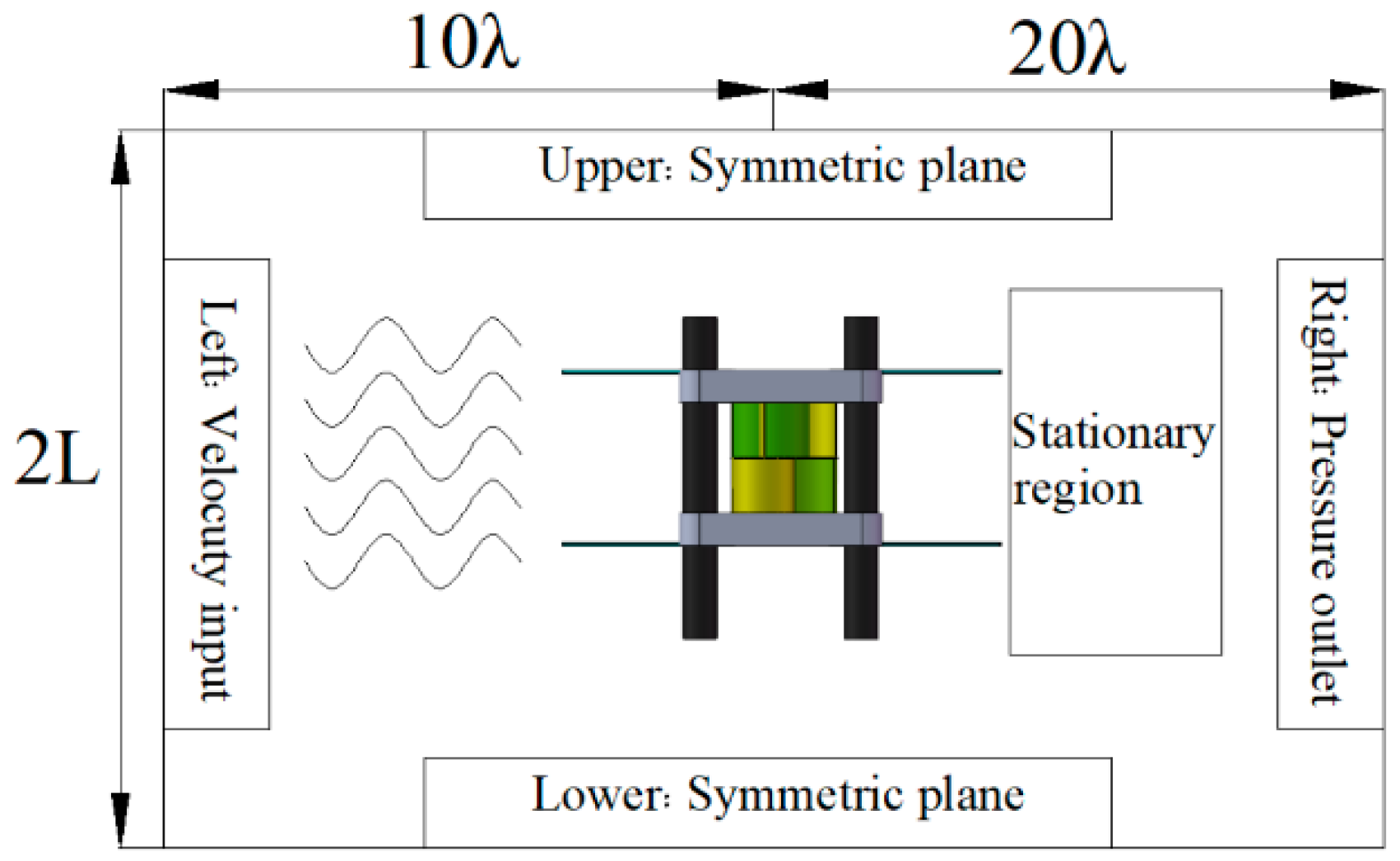



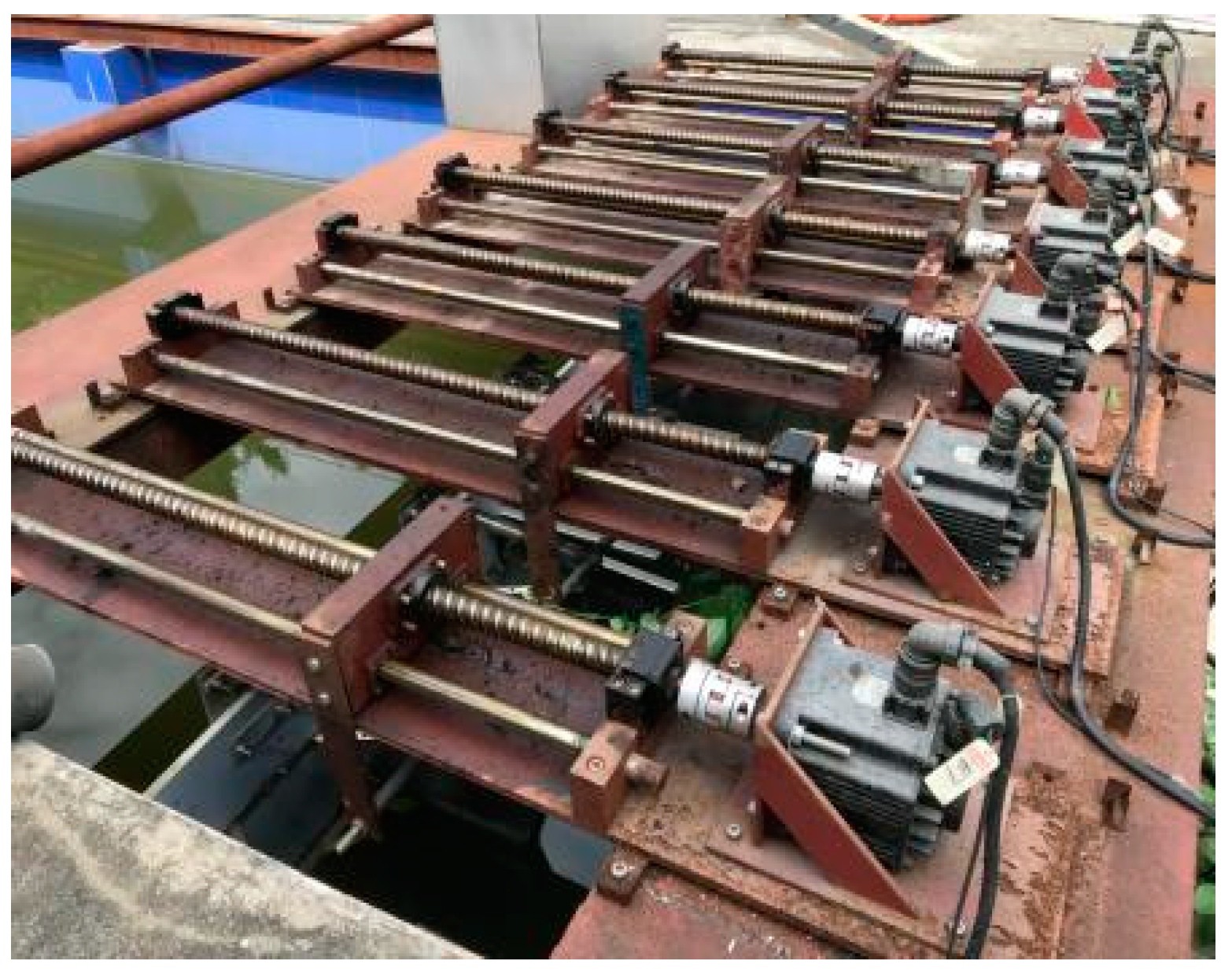
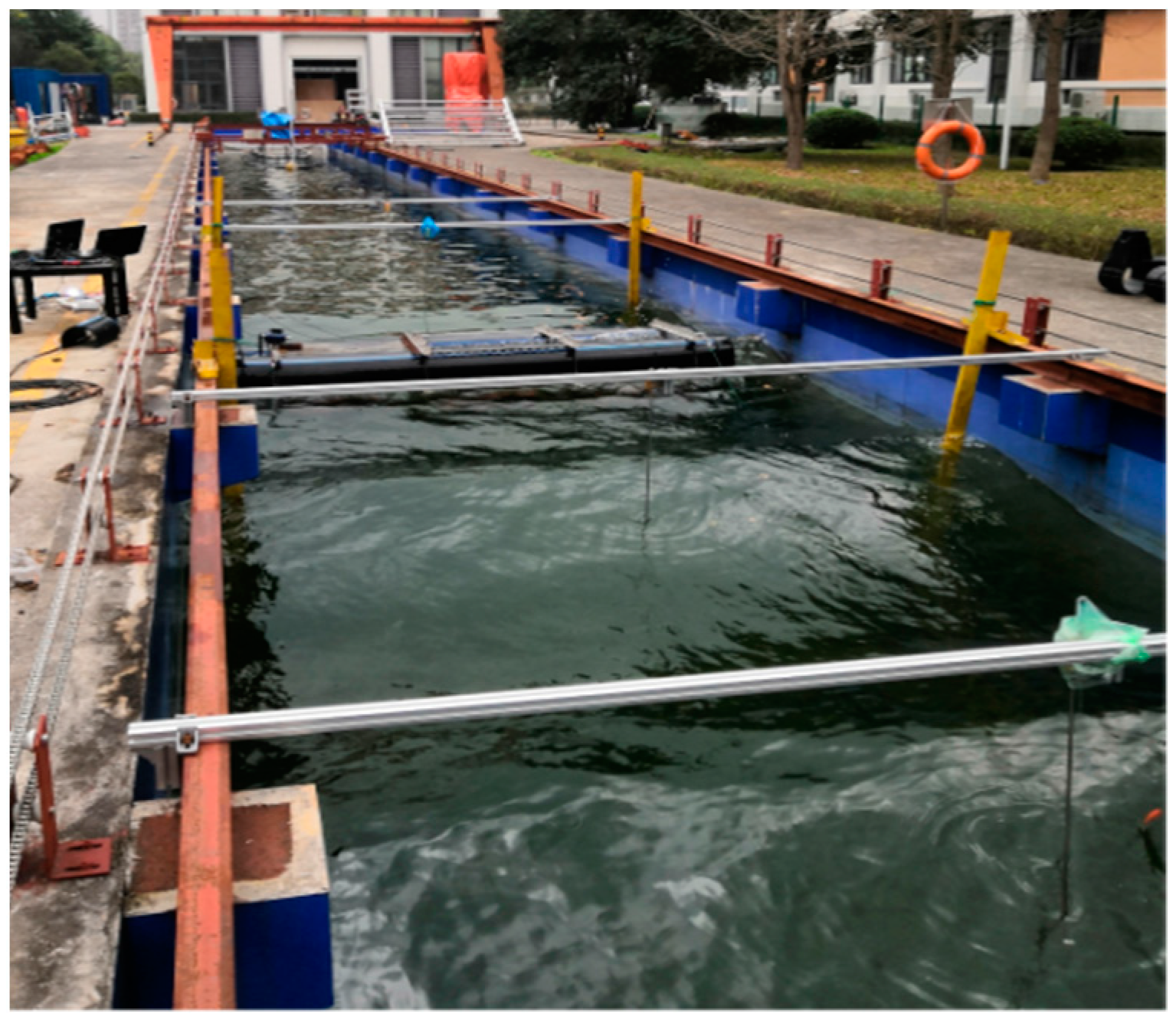

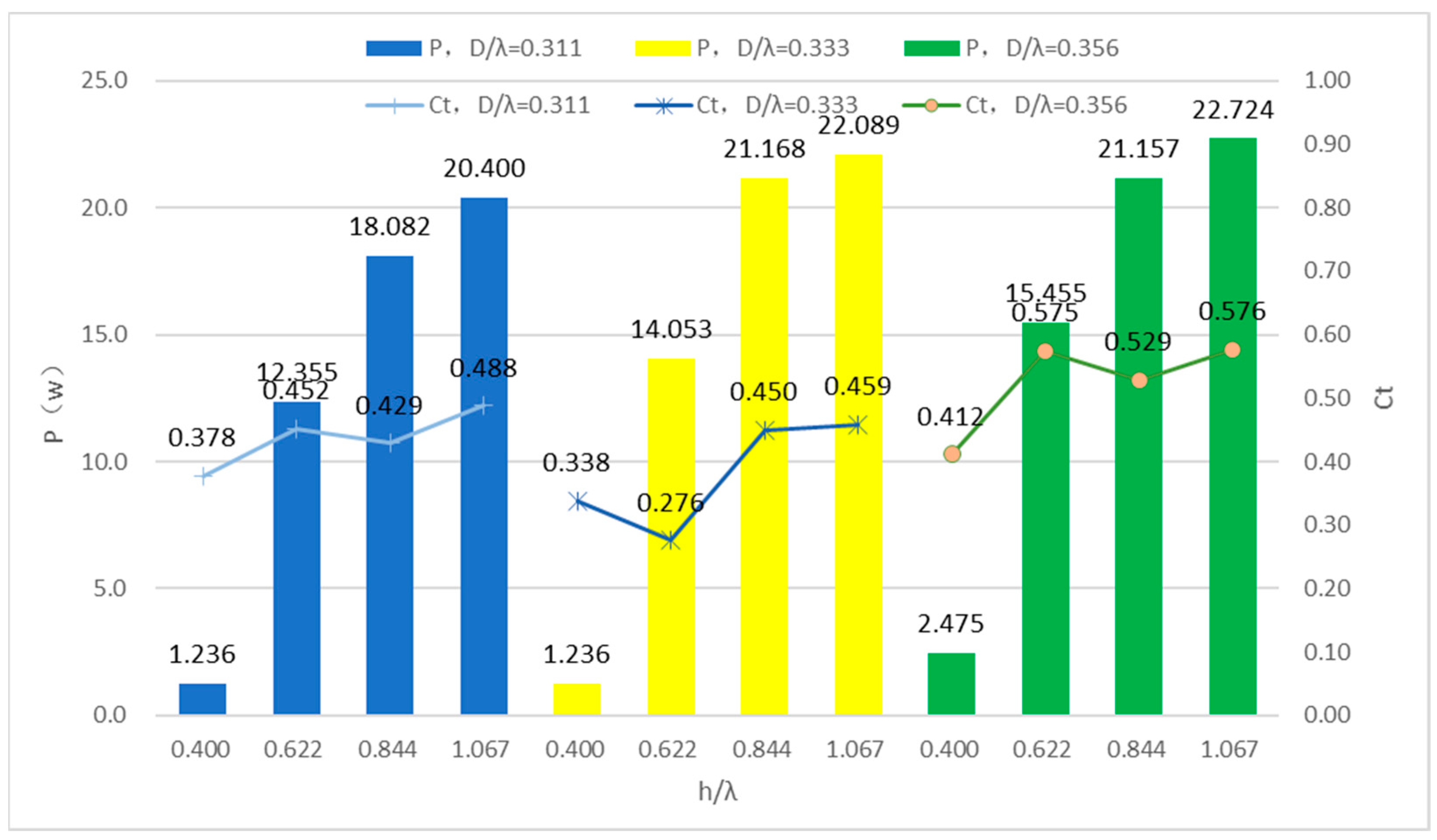
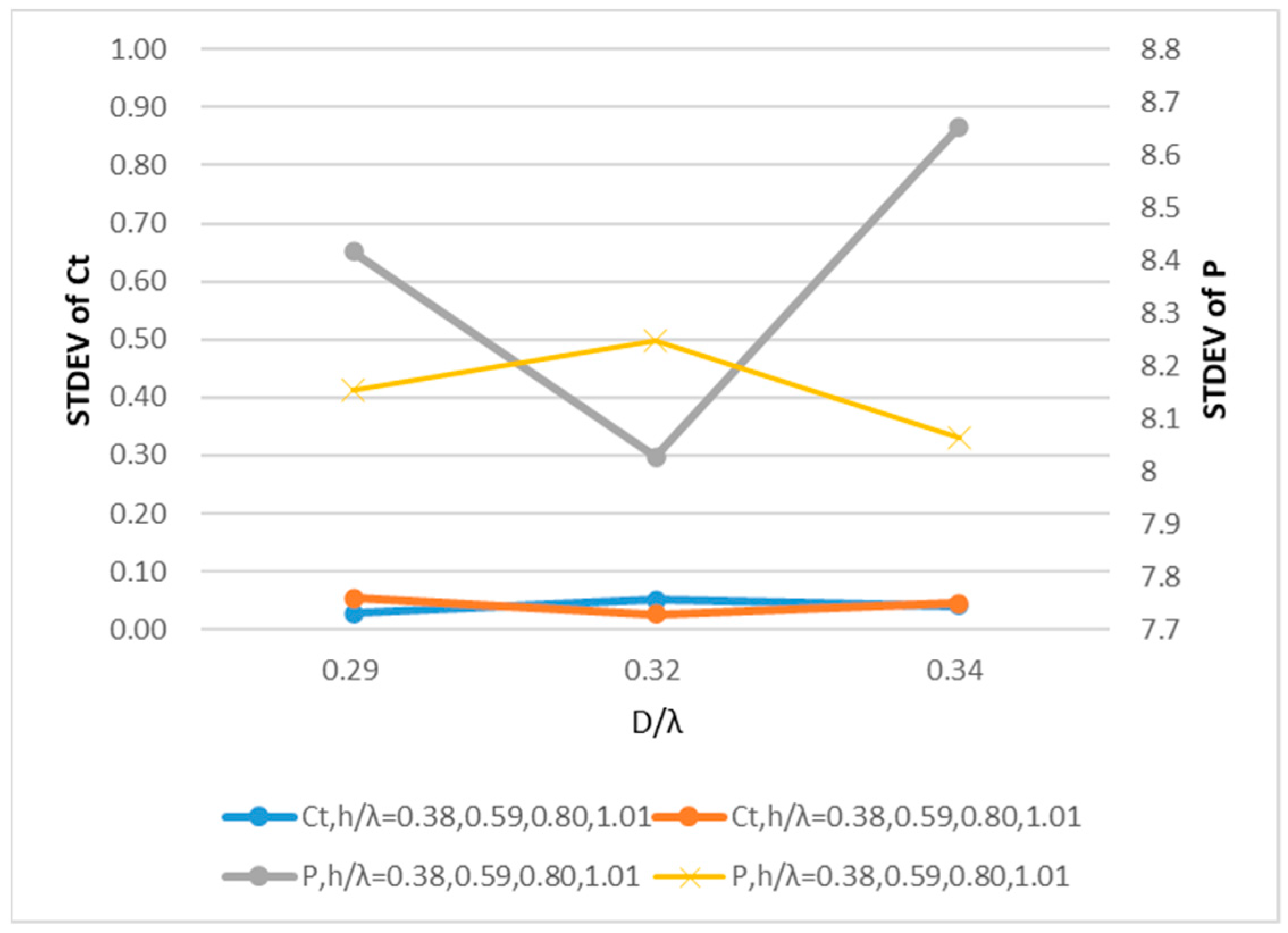






| Parameter | Numerical Value/m |
|---|---|
| floating tube diameter | 0.33 |
| floating tube spacing | 0.65 |
| float length | 3 |
| wheel diameter | 0.5 |
| blade radius | 0.15 |
| wheel height | 0.61 |
| Parameter | Value | Unit |
|---|---|---|
| water depth | 5 | m |
| draft | 1.7 | m |
| HDPE float density | 0.95 | kg/m3 |
| runner displacement | 10 | kg |
| wheel inertia moment | (0.337, 0.337, 0.16) | kg·m2 |
| Parameter | W/λ | D/λ | h/λ | Methods |
|---|---|---|---|---|
| value | 0.274 | 0.320, 0.343, 0.366 | 0.412, 0.640, 0.869, 1.098 | numerical simulation |
| 0.267 | 0.311, 0.333, 0.356 | 0.400, 0.622, 0.844, 1.067 | physical experiment |
Publisher’s Note: MDPI stays neutral with regard to jurisdictional claims in published maps and institutional affiliations. |
© 2022 by the authors. Licensee MDPI, Basel, Switzerland. This article is an open access article distributed under the terms and conditions of the Creative Commons Attribution (CC BY) license (https://creativecommons.org/licenses/by/4.0/).
Share and Cite
Bao, L.; Wang, Y.; Jiang, C.; Chen, J.; Li, H.; Wang, S. Research on Wave and Energy Reduction Performance of Floating Breakwater Based on S-Shaped Runner. Energies 2022, 15, 5148. https://doi.org/10.3390/en15145148
Bao L, Wang Y, Jiang C, Chen J, Li H, Wang S. Research on Wave and Energy Reduction Performance of Floating Breakwater Based on S-Shaped Runner. Energies. 2022; 15(14):5148. https://doi.org/10.3390/en15145148
Chicago/Turabian StyleBao, Lingjie, Ying Wang, Chuhua Jiang, Junhua Chen, Hao Li, and Shenghu Wang. 2022. "Research on Wave and Energy Reduction Performance of Floating Breakwater Based on S-Shaped Runner" Energies 15, no. 14: 5148. https://doi.org/10.3390/en15145148





